Table of Contents
Online education is a dynamic and competitive field, and standing out requires more than quality content. It’s about how you package, market, and monetize that content to create sustainable and growing income sources.
In this article, our focus will be on dissecting and understanding various lucrative business models that have been employed by some of the most successful course creators.
We will touch upon the 17 innovative business models that are changing the game in online education. We’ll look at different ways to turn eLearning platforms into profitable ventures while also providing quality education.
💡For the full insights, we urge you to dive into our comprehensive, on-demand webinar “Generate multiple revenue streams with an online school.” This free on demand webinar delves deeper into each of these strategies, offering insights, real-world examples, and practical tips to implement them effectively and help you enhance your online education business.
Don’t miss this opportunity for an in-depth exploration of pioneering eLearning business models.
Business Models & Strategies to Monetize Your Online Academy
First of all, keep this in mind: it’s not just about choosing a model; it’s about understanding your audience, leveraging your content’s strengths, and staying ahead in the ever-changing landscape of online education.
Each of these models offers a unique approach to monetizing online learning, catering to various niches and learner preferences. The beauty lies in their adaptability and potential for innovation.
Whether you’re a seasoned educator or a budding entrepreneur, understanding these models can be the key to unlocking the full potential of your online academy.
Direct Monetization Strategies
1. The Classic One-Time Purchase:
This model is as straightforward as it gets: Pay once, learn forever. Learners pay once and gain lifelong access to your course.
It’s perfect for content that doesn’t require frequent updates, offering a robust way to monetize niche expertise.
You can boost your earnings potential by cross-selling courses and products after the initial purchase.
The classic one-time purchase model is perfect for specialized fields like photography or medicine where learners want targeted skills.

2. Subscription:
A continuous learning journey: Imagine Netflix, but for learning.
Subscriptions ensure a steady revenue stream and cater to learners who crave continuous upskilling. It’s a dynamic model for a broad spectrum of topics.
This model offers great flexibility and opportunities for growth as you can easily introduce premium features or tiered plans to grow your business.
It also has a broad appeal as it is suitable for all learning sectors, from tech to personal development.

3. Tiered Success:
Tiered pricing is the art of catering to different learners’ needs and budgets. From basic to premium, each level offers more content and personalized features.
This model excels in encouraging users to upgrade for more feature-rich tiers and deepening user engagement.
This model is perfect for businesses offering services, like coaching or consulting. For example, a coaching academy can provide its live 1:1 coaching sessions command for a premium price and offer at the same time entry-level self served courses provide at an affordable price that will help customers start their learning journey.
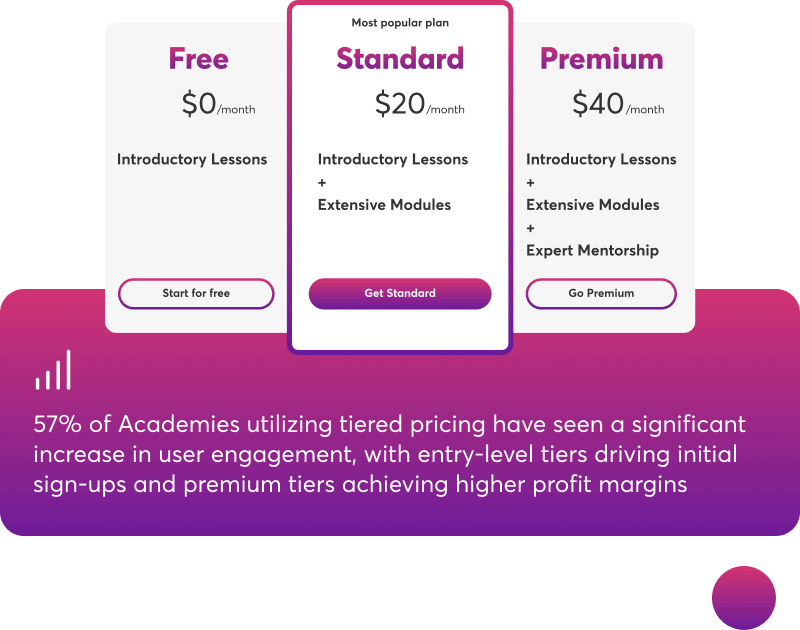
4. Freemium:
The teaser effect: Free content? Yes, but with a twist. The freemium model offers a taste of your courses, luring learners in, and then monetizes through advanced features or content.
It’s a stellar strategy for building a user base. You can start with no-cost content, enticing learners to see the value and upgrade for more, thus converting them to paid customers.
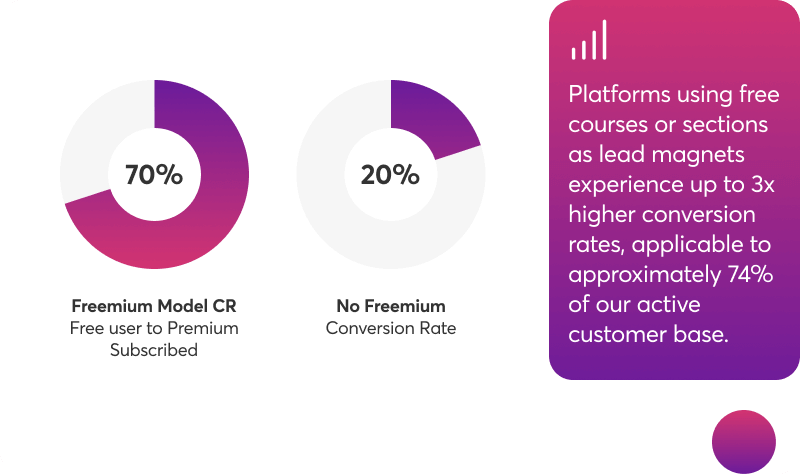
5. Building a Community through Memberships:
Think of a loyal tribe, all eager to learn and grow together. Members pay a fee for exclusive content and community features, ensuring a consistent income and a dedicated user base.
The purpose of the membership community is to transform followers into a dedicated audience, strengthening your educational impact and revenue.

Indirect Monetization Strategies
6. Monetizing Certifications:
Certifications add credibility to any course. Charging for these can be a clever way to add an extra revenue stream while incentivizing learners to complete your courses.
You can offer certifications for course completion, adding value for learners and an additional revenue stream for you. You can even use certification as a strategy for upselling more courses and encouraging re-certification.

7. Strategic Sponsorship:
Aligning with brands or companies can open new monetization avenues. It’s about creating value-packed partnerships that enhance your platform’s offerings.
For example, if you run a financial asset management academy, you can partner with top portfolio management software so that your offerings have broader reach to targeted audiences.
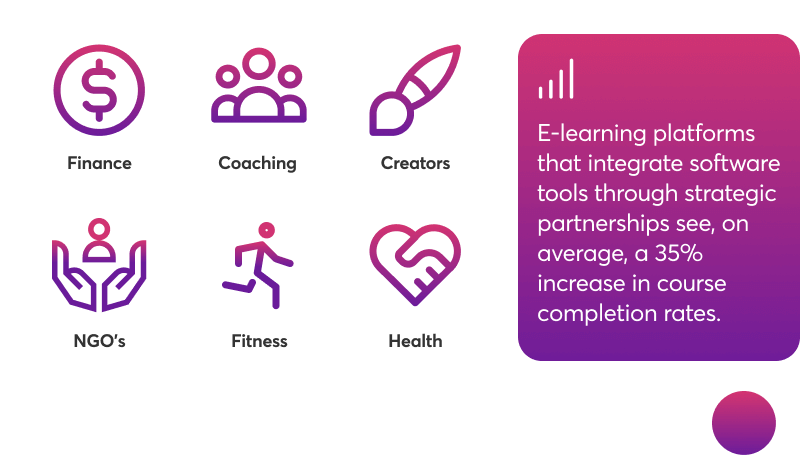
8. The Affiliate Marketing Game:
You can utilize affiliate marketing in two powerful ways
By affiliating with other products or services, you can earn commissions and provide added value to your learners. It’s a win-win strategy for cross-promotion and revenue generation.

9. Licensing:
Share your knowledge, as your content has value. Licensing it to other institutions or platforms can be a lucrative way to extend its reach and generate income.
This indirect monetization model is perfect for specialized fields like IT or healthcare, where your expertise can meet educational needs across institutions without diluting your brand.
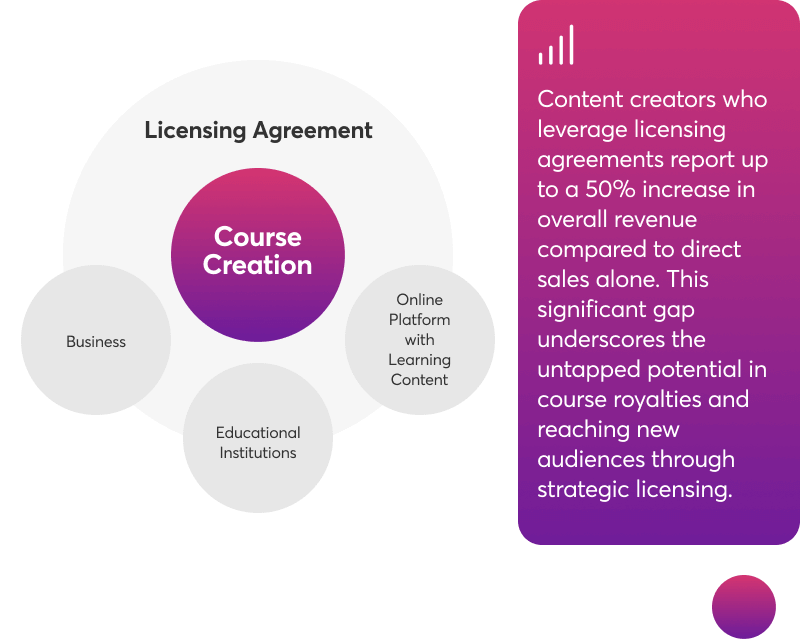
10. Corporate Training:
Tailoring to businesses: Companies constantly seek quality training for their employees. Offering customized eLearning solutions to businesses can unlock significant revenue potential.
You can create tailored training solutions that align with corporate goals and workforce needs.
In this case, revenue models can range from per-session, per learner pricing to flat rates for comprehensive training solutions, often incorporating branded course materials.
The corporate training model is a great fit for sectors needing ongoing professional development like IT, HR, and Leadership.
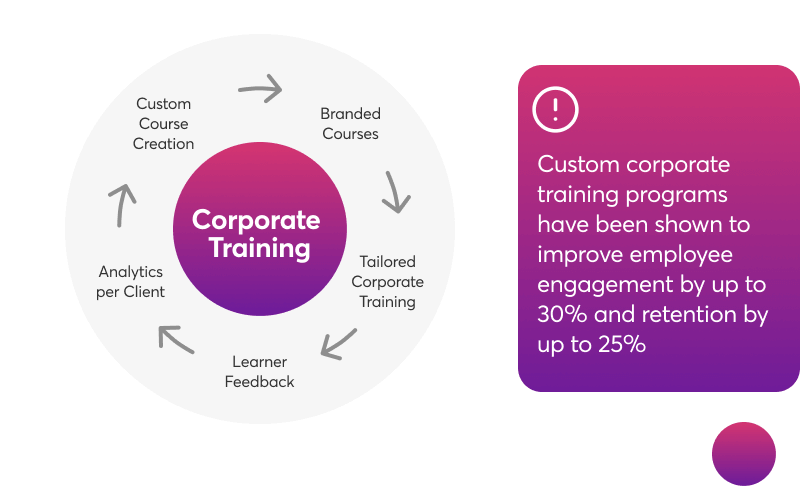
11. Consultation:
Beyond the course: Post-course consultations can be a goldmine. They provide personalized value to learners while significantly boosting your earnings.
You can provide one-on-one or group consultations to enhance course effectiveness and skill application.
Keep in mind that expert sessions can significantly increase revenue, adding a premium option to your course offerings.

12. Job Placement Services:
By connecting your course graduates with potential employers, you create an ecosystem that benefits all parties and opens up a new revenue channel.
You can tap into a new revenue stream by earning placement fees, enhancing your platform’s profitability.

13. Merchandising:
Selling course-related merchandise can not only boost revenue but also increase brand visibility and loyalty.
This way, you open an additional revenue stream with significant profit margins for your online course business.
For example, if you run a photography academy, you can pair your courses with custom photography accessories, as a way to spike your course sign-ups and increase your revenue at the same time.
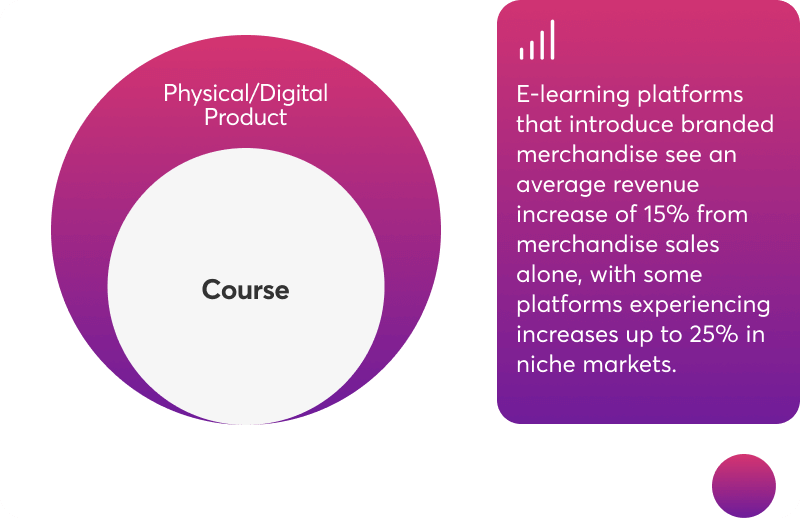
Emerging Business Models
14. Hybrid Learning and Subscription Boxes:
This innovative model combines online learning with physical products. It enhances the learning experience and offers a unique way to monetize.
You can merge online learning with physical products and deliver themed boxes with educational tools and resources. This will help keep your learners engaged and provide you with a consistent revenue stream.

15. Royalties and Reselling:
Earning royalties from your courses or reselling them can provide a passive income stream, particularly for high-demand or evergreen content.
This business model is ideal for those of you looking to scale without creating new content, and course creator experts and /or consultants.
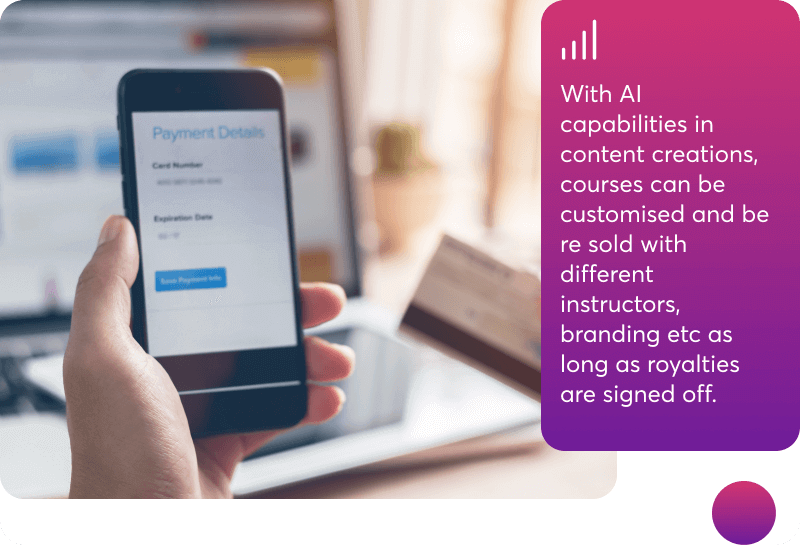
16. Blockchain Certifications:
Offering blockchain-backed certifications can add a layer of credibility and uniqueness to your courses, appealing to tech-savvy learners.
If you are a tech company, you can make your online courses more attractive for app building by issuing a blockchain certification at the end of the course.

17. Mobile App Monetization:
Transform your courses into app-based learning experiences. With in-app purchases, you can tap into the mobile market and open new revenue streams.
Also, keep in mind that microlearning via mobile apps increases course completion rates.
With this business model you are reaching out to an on-the-go audience who are usually more willing to pay a more premium pricing for this flexibility.

Choosing the Right Model for Your Business
The business models we’ve discussed are not just innovative examples of eLearning’s potential; they are powerful tools for global empowerment. These models go beyond mere profit-making strategies—they are transformative pathways that open doors to knowledge and opportunity for learners everywhere.
This brings us to a pivotal decision: which of these groundbreaking models aligns best with your vision?
To guide you through this crucial choice, we invite you to watch our free, on-demand webinar: “Generate multiple revenue streams with an online school.” This is a webinar meticulously designed to offer you deeper insights into each model and to provide you with a strategic framework for making the most informed decision for your business.
Don’t miss this opportunity to unlock the full potential of your online school. Click the button below to access the webinar video now and take the first step towards shaping the future of your education business.
Rosemary is LearnWorlds’ Content Marketing Manager. She has over 2 decades of experience in omnichannel marketing and content writing for the IT and SaaS industry. Her expertise lies in crafting effective content marketing strategies that attract, engage, and nurture customers, enabling LearnWorlds to reach its target audiences with precision.


